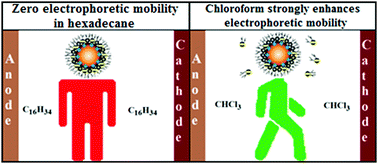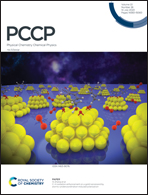The formation of free ions and electrophoretic mobility of Ag and Au nanoparticles in n-hexadecane–chloroform mixtures at low concentrations of AOT
Abstract
The electrophoretic mobility of Ag and Au nanoparticles in n-hexadecane–chloroform mixtures was studied as a function of the chloroform content (from 0 to 100 vol%). The nanoparticles were stabilized by sodium bis-(2-ethylhexyl)sulfosuccinate (AOT, Aerosol OT) with a concentration of 2.5 × 10−4 mol L−1. The obtained organosols were characterized by phase analysis light scattering, dynamic light scattering, transmission electron microscopy, diffusion-ordered spectroscopy of nuclear magnetic resonance, spectrophotometry and conductometry. The electrophoretic mobility of the nanoparticles sharply increased from 0 to 3.6 × 10−9 m2 V−1 s−1 with increasing chloroform content. The growth of the mobility was caused by an increase in the concentration of solvated AOT ions, which formed by the disproportionation reaction from uncharged molecules. Low concentrations of AOT and a considerable zeta potential (up to ∼100 mV) made it possible to use the obtained organosols for the formation of electrostatically bound aggregates of Ag and Au with negatively charged SiO2 nanoparticles.



 Please wait while we load your content...
Please wait while we load your content...